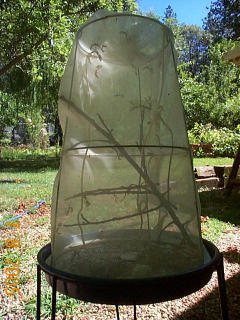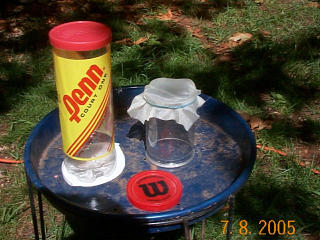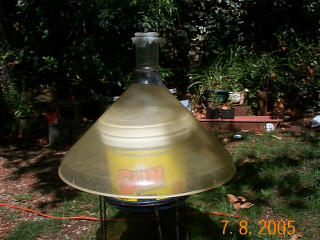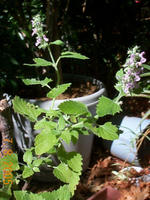

These are images of one of the cheap cages I showed how to make in an earlier post, but now it is filled with two month old praying mantises. This type of cage works well for raising mantids, especially if you are feeding winged flies as they do not tend to escape when released, although the mantids will try to escape during the first few feedings until they figure out the routine. The sticks I placed in the cage are not necessary until the mantids are ready to mate, but I did not realize that at the time I put them in and now it would be too disturbing to take them out, but the mantids prefer to cling to the sides of the mesh and the top of the cage is the most popular area. I have found that if you place a single cricket in the cage, it will keep things somewhat stirred up and force fly movement to help the circulation in the cage.
One of the flaws in this type of cage is that you can not see as well as through an aquarium, as the mesh creates a filtered view and lower humidity, but it does allow for good air circulation. The first image shows more close ups of mantid silhouettes.
 Hanging upside down in her new breeding cage, this adult female praying mantis gets a taste for crickets. In this cage, which is an old aquarium with a fine mesh top the mantis prefers to hang upside down as she can get better footing clinging to the mesh screening. It is necessary to place a small branch or other bridging so that the crickets can climb up to the top of the cage, as they will not climb up the glass. I keep two females in this cage and they have been co-habiting it for about three weeks without any aggressive acts towards each other. The cage is 24 x 12 x 12. The first thing she does after catching the cricket is to gnaw off its head and drop the unappetizing parts of it to the bottom of the cage. She then leisurely finishes the rest of it.
Hanging upside down in her new breeding cage, this adult female praying mantis gets a taste for crickets. In this cage, which is an old aquarium with a fine mesh top the mantis prefers to hang upside down as she can get better footing clinging to the mesh screening. It is necessary to place a small branch or other bridging so that the crickets can climb up to the top of the cage, as they will not climb up the glass. I keep two females in this cage and they have been co-habiting it for about three weeks without any aggressive acts towards each other. The cage is 24 x 12 x 12. The first thing she does after catching the cricket is to gnaw off its head and drop the unappetizing parts of it to the bottom of the cage. She then leisurely finishes the rest of it.










